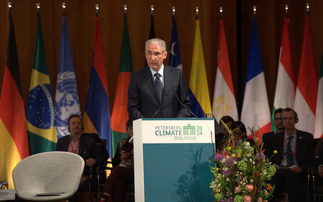
Industry Voice: There is clearly much work to be done in order to cut global emissions permanently, according to Signify
As a result of worldwide Covid-19 restrictions and lockdowns, global greenhouse gas (GHG) emissions fell between 4.2 per cent and 7.5 per cent, depending on how you measure them. But this was certainly no 'silver lining' of the global pandemic.
According to the World Meteorological Organisation (WMO) it was "a ‘tiny blip' in the continuous buildup of greenhouse gases in the air caused by human activities, and less than the natural variation seen year to year".
One analogy for the Covid emissions dip was that the bath was still filling with water but that the flow had slightly reduced. Nevertheless, the bath was still filling up at a rate that would cause a serious problem unless addressed.
As discouraging as that might be to people looking for some good climate news, the WMO's State of the Global Climate report is even more sobering. The WMO uses seven climate indicators to give a broad view of the global climate, and the level of GHG emissions is only one of them. The others are temperature, ocean heat, sea level, glacial mass, sea ice, and ocean acidification.
Increasing levels of greenhouse gases in the atmosphere due to human activities are a major driver of climate change" - WMO
However, the level of GHG emissions has a special role to play, as the leading cause of changes in the other six indicators. "Increasing levels of greenhouse gases in the atmosphere due to human activities are a major driver of climate change," the WMO states bluntly.
Most of the 'Covid emissions dip' can be attributed to the temporary decrease in automobile traffic on the one hand and the temporary slowdown in industrial activities on the other. Emphasis on 'temporary': because as soon as pandemic restrictions are lifted, GHG emissions rebound. Climate experts have said that "the trajectory of global emissions in the years ahead is likely to be heavily influenced by the stimulus measures that countries enact as they seek to revive their economies". Clearly, there is much work to be done in order to cut global emissions permanently.
One way to help do that is to reconceive the built environment with the goal of achieving sustainability. Internet of Things (IoT) technology is increasingly giving us the tools to do just that. The IoT is laying the foundation for an entirely new conception of how to build, operate, and maintain urban centers and the structures that comprise them. With the European Green Deal and similar climate-neutral programs in other parts of the world, the year 2021 may well be the year that smart city and smart building approaches become the rule rather than the exception.
For more details, read this article on some smart approaches that can help end the emissions crisis, using Interact, Signify's connected lighting software and systems for the IoT.
This article is sponsored by Signify.








